I have been to Svalbard five times over the years, and one thing I can say about the archipelago is that each season and month brings noticeable change.
This guide will dive into the three seasons in Svalbard: summer, winter, and sunny winter (spring). I will break down each month and what there is to do, well-known festivals, and what kind of weather to expect.
I hope you get an idea of when the best time to visit Svalbard is for the type of trip you wish to have!
If youʻre booking your trip to Svalbard last minute, we have you covered. Below are some of the top tours, and more!
🐋 Top Summer Activities in Svalbard:
- Speedboat tour to walrus colony (one of my favorites!)
- Nature and wildlife tour on a boat (top-seller)
- Wildlife photography tour (not a boat tour, but awesome!)
❄️ Top Winter Activities in Svalbard:
- Snowmobile to the land of the polar bear (Feb-May)
- Northern lights snowmobile trip (Dec-Mar)
- Historic coal mine tour at Gruve 3
🛌 Top Hotels and Places to Stay:
- Haugen Pensjonat Svalbard (my FAVORITE place to stay!)
- Radisson Blu (good base for activities!)
- Coal Minerʻs Cabins (budget option, further from town)
Before diving into the individual months, I will give a quick overview of the highs and lows for each season. Please note that things are ever-changing!
Svalbard is trying to develop its winter tourism to ‘spread the wealth’, so new festivals and events are popping up every so often, making the place a great destination any time of the year!
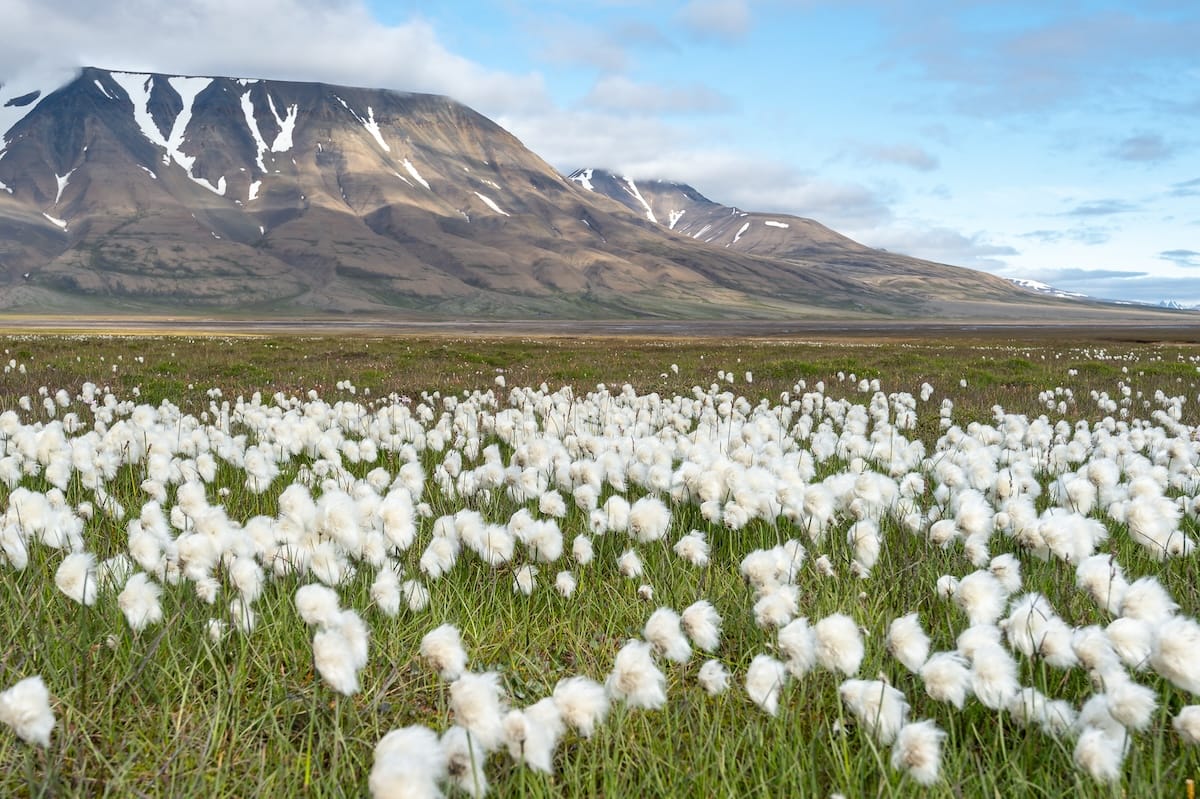
Let me know if you have any questions about when to visit Svalbard and what to do during each season (and month). Thanks!
In this post...
Winter (October–February)
I don’t care what anyone says; visiting Svalbard in winter is dreamy! Just like most places in Norway. The cruise ships are gone, and the town of Longyearbyen is cozy and without the large crowds.
From October to January, things slow down, and the northern lights start to show up. Longyearbyen has a phenomenal restaurant scene for such a small place, and I think this is the time to go there and enjoy some Arctic fine dining.
Another perk for visiting during this time of the year is that prices are significantly cheaper! I found very affordable hotels and flights during February!
A con of visiting Svalbard in early winter is that the snowmobile tours are not usually available until the end of January or the beginning of February.
Svalbard in October
🌡️ Temperature Range: -10°C to -5°C (14°F to 23°F)
❄️ Average Monthly Snowfall: Ranges from 11.8 cm to 23.1 cm (4.6 inches to 9 inches)
October in Svalbard marks the start of the winter season, so temperatures are still relatively mild (in terms of the winter, anyway).
The Polar Night is not yet upon us, so you can take advantage of the low crowds while still having some daylight (although this will decrease as you head through October).
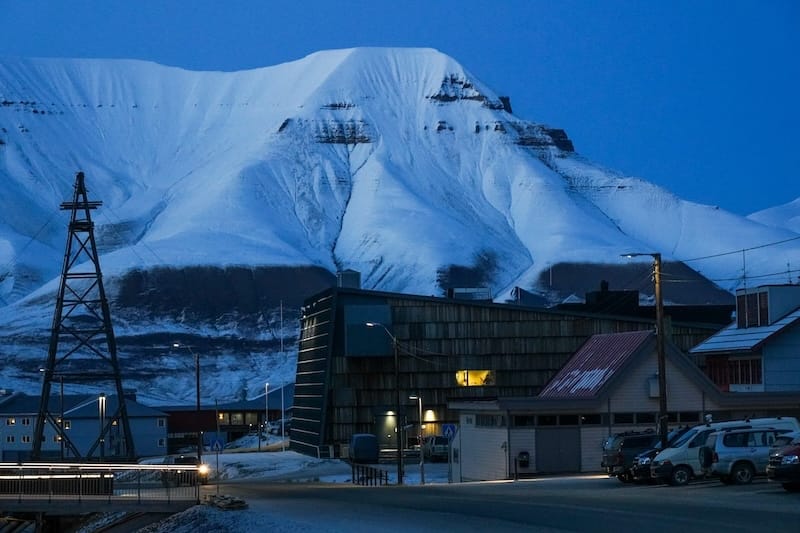
Luckily, this decrease in daylight offers you the chance to spot the northern lights, with the Aurora Borealis season starting in late September.
As the snow starts to return, it’s a great time of year for photographers, especially as polar bears and walruses can still be spotted into mid-October (you can see them year-round, but it’s usually easiest until then).
The Dark Season Blues Festival and Taste Svalbard Festival both take place in Svalbard in October too. Taste Svalbard is a great way to sample flavors from the delicious restaurants in Longyearbyen.
Svalbard in November
🌡️ Temperature Range: -12°C to -7°C (10.4°F to 19.4°F)
❄️ Average Monthly Snowfall: Approximately 23 cm (9 inches)
The Polar Night begins in mid-November, and the sun won’t rise again until late February (but a bit of light rolls around in January). With the Polar Night, you’ll experience 24 hours a day of total darkness.
Although this may sound strange, you’ll have a great chance of spotting the northern lights during November in Svalbard. You can even spot them during the day if you’re lucky!
Due to the lack of snow, you’ll find that the majority of winter activities aren’t running yet (i.e., snowmobiling and dog sledding).
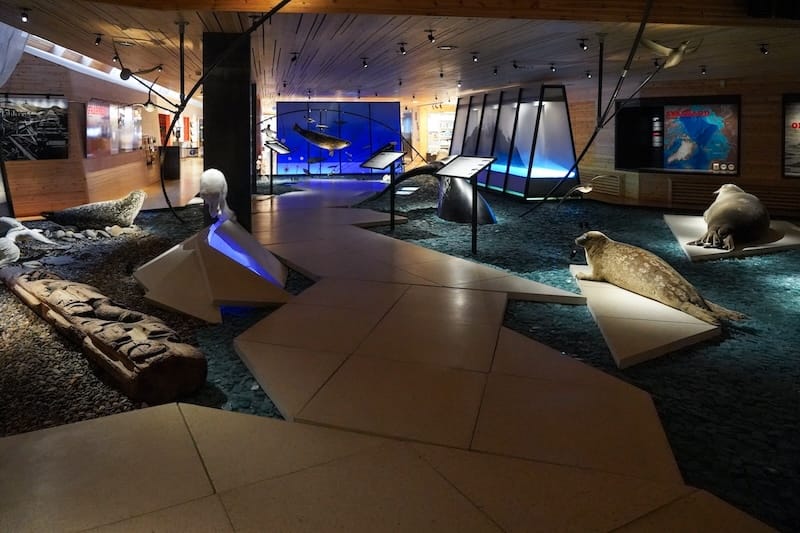
However, some boat trips do run from Longyearbyen until the end of November (sometimes early December), so you can explore Svalbard this way.
Longyearbyen also offers two great museums, the North Pole Expedition Museum and the Svalbard Museum, which are perfect for those visiting Svalbard in November.
Svalbard in December
🌡️ Temperature Range: -15°C to -9°C (5°F to 15.8°F)
❄️ Average Monthly Snowfall: Ranges from 23.3 cm to 26.5 cm (9.1 inches to 10.4 inches)
The best reason to visit Svalbard in December is the Christmas festivities. Although the polar night can limit other activities, there’s plenty to do at this time of year.
On the first Sunday of Advent, a torchlit walk takes place every year up to the letterbox in Nybyen. Here, you can post a letter to Santa Claus!

The lighting of the Christmas tree also takes place on this day, and the streets are adorned with decorations. For the ultimate festive experience, stay at the ‘Christmas Hotel’ (found at the Basecamp Explorer Hotel).
December in Svalbard is also perfect for visiting the world’s northernmost chocolaterie at Fruene (be sure to also grab lunch there; I love their soup!).
Svalbard in January
🌡️ Temperature Range: -16°C to -9°C (3.2°F to 15.8°F)
❄️ Average Monthly Snowfall: Ranges from 22.8 cm to 26.4 cm (8.9 inches to 10.3 inches)
If you plan to visit Svalbard in January, then be prepared for the start of very chilly temperatures and harsh conditions (the winds here are something else).
The days are still dark, but the sun will bring a little light for the first time in months at the very end of January in Svalbard (this is not a sunrise—just not 24 hours of pure darkness).
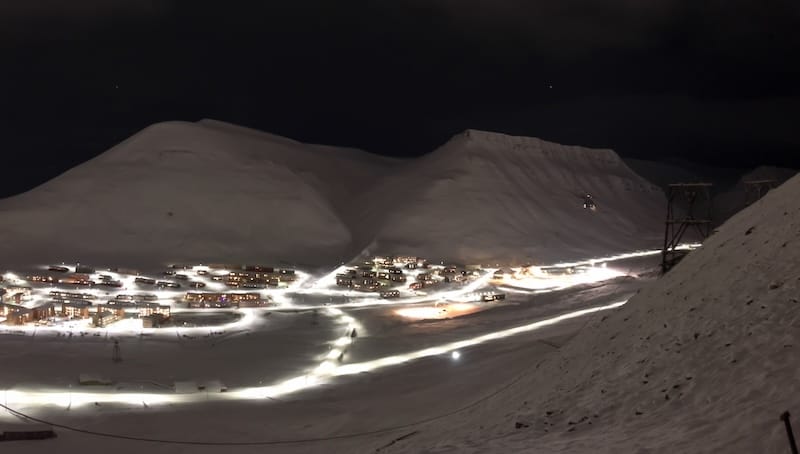
Thanks to the past few months of snowfall, winter activities are now readily available, with snowmobiling being a great option at the end of the month into early February.
Just keep in mind that if you visit right at the start of January, some businesses may still be closed for the festive period.
Svalbard in February
🌡️ Temperature Range: -16°C to -10°C (3.2°F to 14°F)
❄️ Average Monthly Snowfall: Ranges from 22.7 cm to 24.4 cm (8.9 inches to 9.6 inches)
Now we’re coming toward the end of the winter season, especially as the Polar Night has ended.
As there’s more daylight, February in Svalbard is the perfect time to visit if you want to do winter activities.
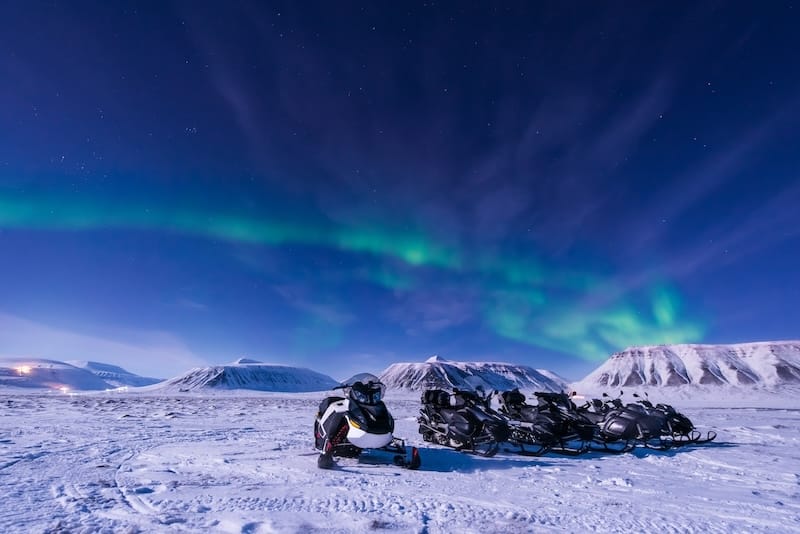
Skiing and snowmobiling are both very popular, as is dog sledding. Not to mention, you can still spot the northern lights at this time of year, as well as the unique ‘Blue Hour’ phenomenon.
If you’re a music lover, then this is the month to visit Svalbard. During February, two fantastic music festivals are running: the PolarJazz Festival and the Arctic Chamber Music Festival.
Sunny Winter / Spring (March–May)
Spring (or ‘Sunny Winter’) on Svalbard means that the days get longer and activities start ramping up! March is full-on snowmobile season, and you can find several tours to ice caves, mountain valleys, and more during this time of the year.
April is also a popular snowmobile month, while May is when most boat tours start becoming available.
But, beware, boating opportunities can come and go during May, as the ice may refreeze at the last minute like it did when I went to Pyramiden for the first time.
Another perk of visiting Svalbard from March until May is that prices are not as expensive as in the summer months.
Svalbard in March
🌡️ Temperature Range: -16°C to -10°C (3.2°F to 14°F)
❄️ Average Monthly Snowfall: Ranges from 21.5 cm to 25.2 cm (8.4 inches to 9.9 inches)
March in Svalbard marks the start of ‘Sunny Winter’. During this time, the landscapes are covered in snow, and there’s light during the day, making it a better time for exploration. You’ll also experience the sky’s gorgeous pastel colors (known as ‘Pastel Winter’).
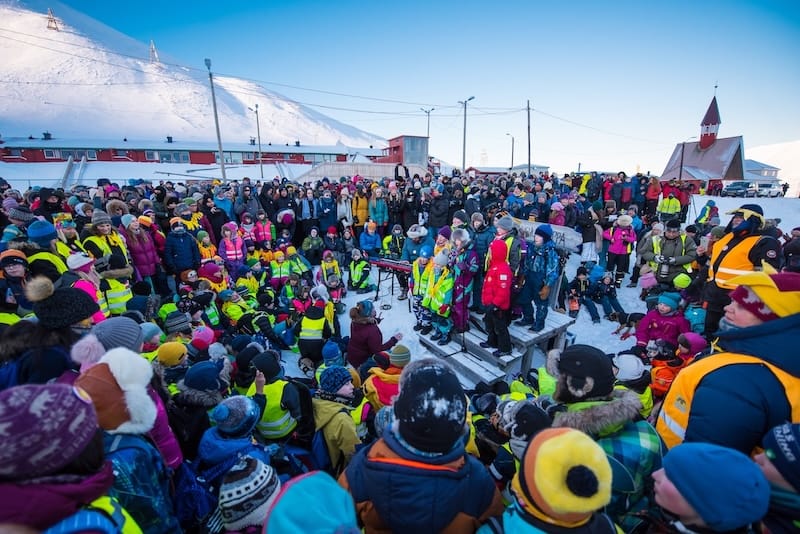
Thanks to the extended daylight hours, March offers an array of different activities, including snowmobiling and dog sledding. Solfestuka (Sun Festival Week) also takes place at this time of year.
The northern lights season runs until mid-March. If seeing the Aurora Borealis is on your bucket list, you’ll want to visit at the start of the month. The darkness runs out very quickly during March, and the season ends abruptly.
Svalbard in April
🌡️ Temperature Range: -9°C to -4°C (15.8°F to 24.8°F)
❄️ Average Monthly Snowfall: Ranges from 13.5 cm to 21.3 cm (5.3 inches to 8.3 inches)
The midnight sun occurs from the 20th of April, so the sun won’t set again until late August. Although there’s still plenty of snow on the ground, you’ll feel warmer temperatures creeping in too.
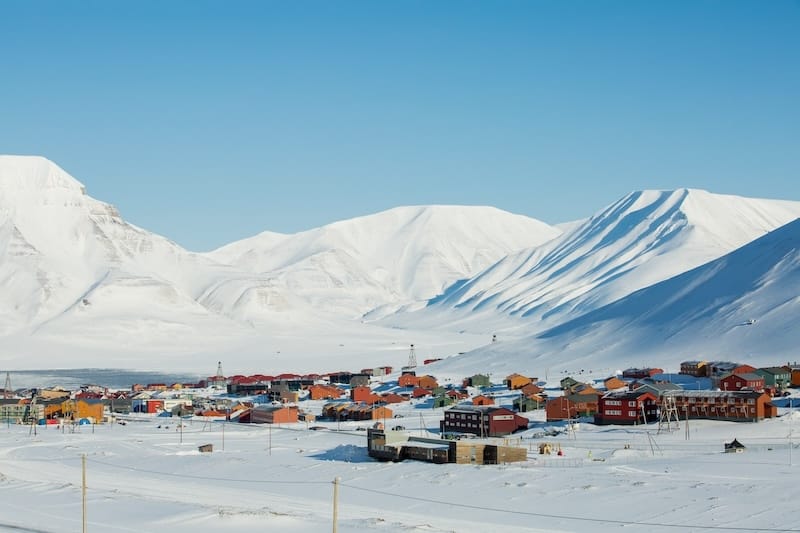
The first migratory birds start to arrive in Svalbard in April, and polar bears can be seen hunting on the sea ice. This is a popular time of year for photographers who want to capture the Svalbard glaciers and ice caps.
Along with the variety of winter activities on offer, the Svalbard Ski Marathon also takes place in April. It’s the world’s northernmost touring race and is great for spectators.
Svalbard in May
🌡️ Temperature Range: -1°C to 2°C (30.2°F to 35.6°F)
❄️ Average Monthly Snowfall: Ranges from 4.4 cm to 13.1 cm (1.7 inches to 5.1 inches)
Boasting 24 hours of daylight and charming snowy landscapes, May has a lot to offer. It’s also a great time of year for wildlife, as the coastal ice is starting to break up.
May marks the start of whale-watching season in Svalbard, where you can spot many species, including humpbacks, belugas, blue whales, and minke whales.
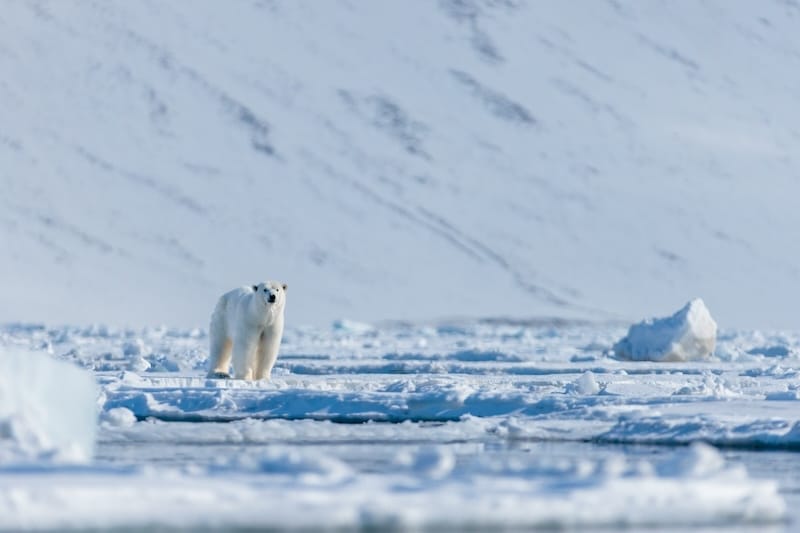
More migratory birds make their way to Svalbard in May, and polar bears and their cubs can also be spotted on the sea ice. This makes it a great time to visit for nature lovers!
Land-based trips are also popular as the snow is starting to melt.
Summer (June–September)
Summer in Svalbard is stunning. The fjords are open for business, and the boats go back to the sea. The animals start flocking back, and Svalbard becomes a haven for birds, walruses, and more.
Prices are at their highest, and the cruise ships return, making Longyearbyen rather crowded during the daytime when the ships are at port.
During the midnight sun months, it is light 24 hours a day.
Svalbard in June
🌡️ Temperature Range: 4°C to 7°C (39.2°F to 44.6°F)
❄️ Average Monthly Snowfall: Ranges from 0.4 cm to 3.8 cm (0.1 inches to 1.4 inches)
The month of June marks the start of summer, the peak season for Svalbard travel. Temperatures are warmer, the landscapes become greener, and the tundra is covered in wildflowers.
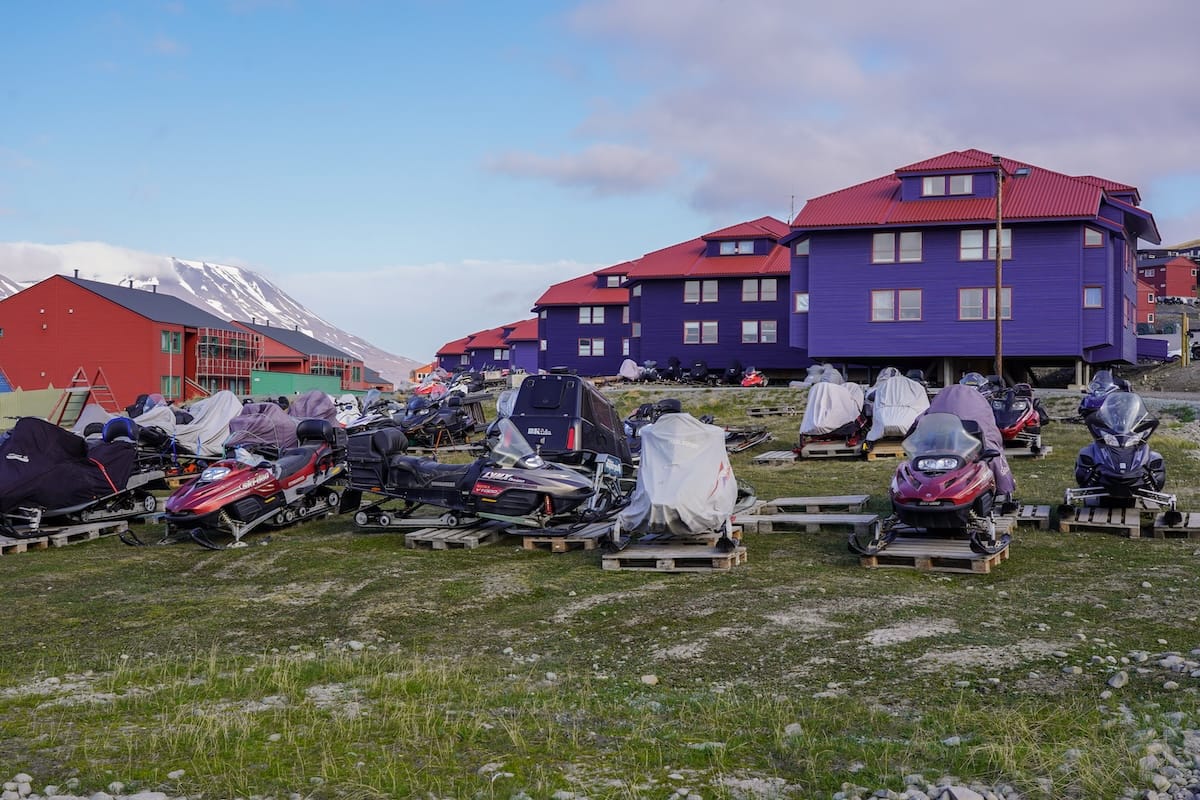
June is another big month for wildlife, with migratory birds, polar bears, walruses, and whales frequently sighted. Thanks to the receding sea ice, cruises and boat trips are popular at this time of year, as well as kayaking.
Hiking is another great activity in June, where you can encounter land-based wildlife such as arctic foxes and reindeer. Wheeled dog sledding is an alternative way to explore Svalbard’s landscapes.
Svalbard in July
🌡️ Temperature Range: 5°C to 8°C (41°F to 46.4°F)
❄️ Average Monthly Snowfall: N/A
July is one of the busiest times to visit Svalbard, so you’ll need to book accommodation in advance. I’d recommend booking tours and activities before your trip as well.
However, it’s busy for a reason, thanks to the variety of activities on offer and wildlife-watching opportunities. July is also the warmest month in Svalbard, where you can even take a polar dip if you dare!
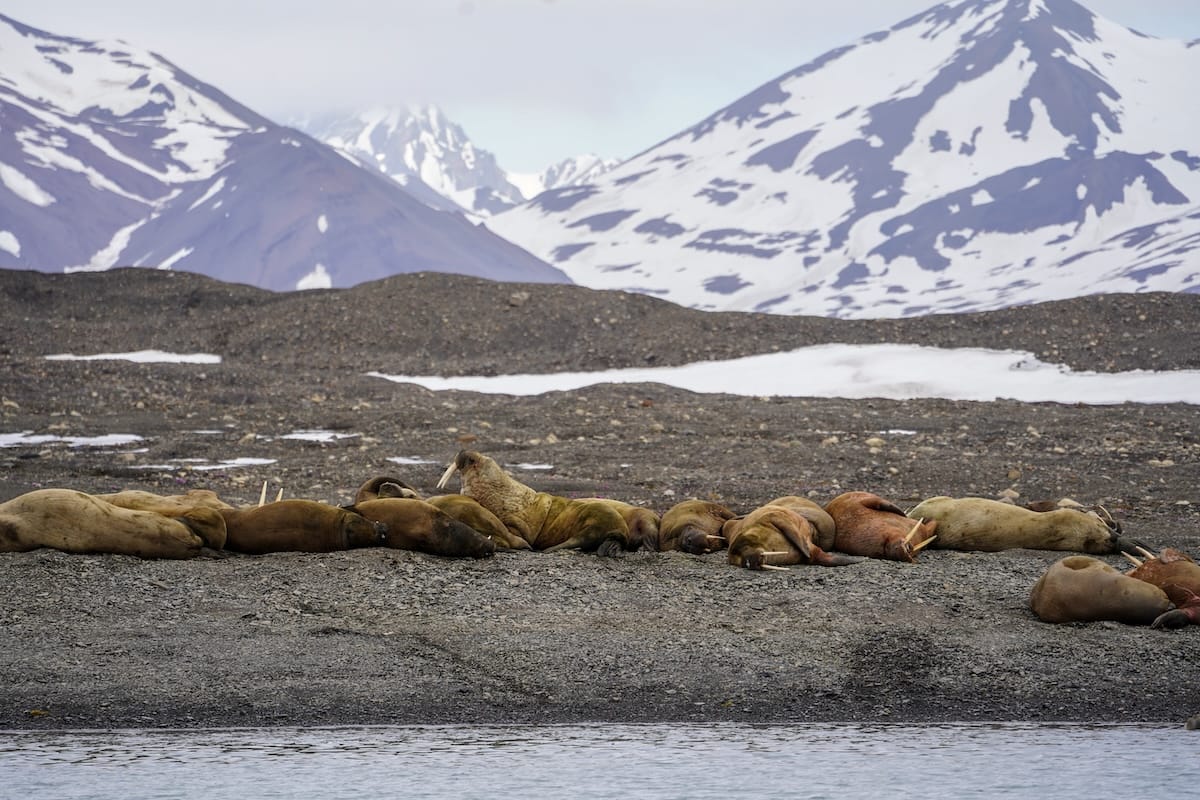
Aside from the wildlife, the main reason to visit in July (or August) is that Spitsbergen (the largest of Svalbard’s islands and where Longyearbyen is located!) typically becomes navigable at this time of year.
Svalbard in August
🌡️ Temperature Range: 2°C to 5°C (35.6°F to 41°F)
❄️ Average Monthly Snowfall: N/A
At the start of the month, you’ll still have 24 hours of daylight, but the midnight sun comes to an end in late August when it finally drops below the horizon.
Even though temperatures are starting to fall, it’s still a great time of year for wildlife watching. For keen bird watchers, you’ll want to visit before mid-August, as this is when most migratory birds depart Svalbard.
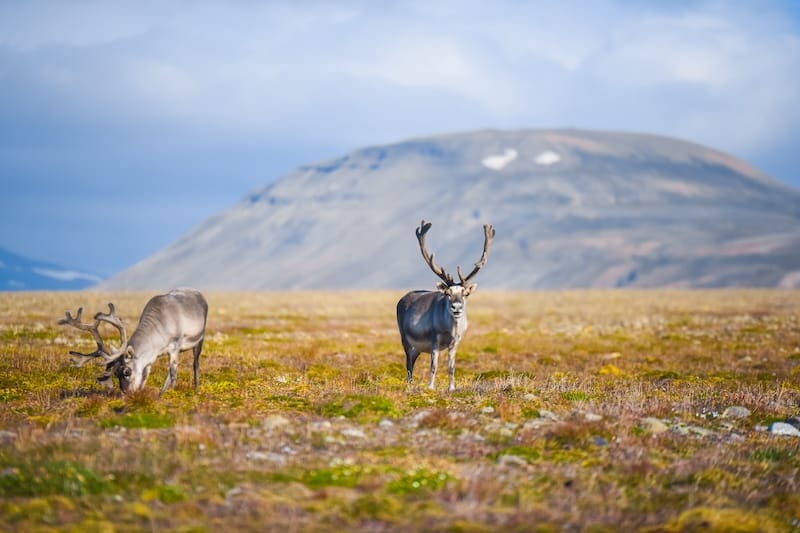
A highlight of visiting in August is the Longyearbyen Pride Festival. Taking place over four days, the world’s northernmost Pride parade includes a rainbow party and free cinema.
August in Svalbard also offers some of the last opportunities to explore the snow-free tundra.
Svalbard in September
🌡️ Temperature Range: -3°C to 0°C (26.6°F to 32°F)
❄️ Average Monthly Snowfall: Ranges from 1.3 cm to 11.2 cm (0.5 inches to 4.4 inches)
As temperatures start to fall below freezing, you can expect some snowfall (although this can be pretty low). Since the midnight sun has ended, you can also enjoy beautiful sunrises and sunsets, as well as stunning autumnal colors.
Northern lights season also starts in late September, so keep your eyes peeled for the aurora borealis at night.
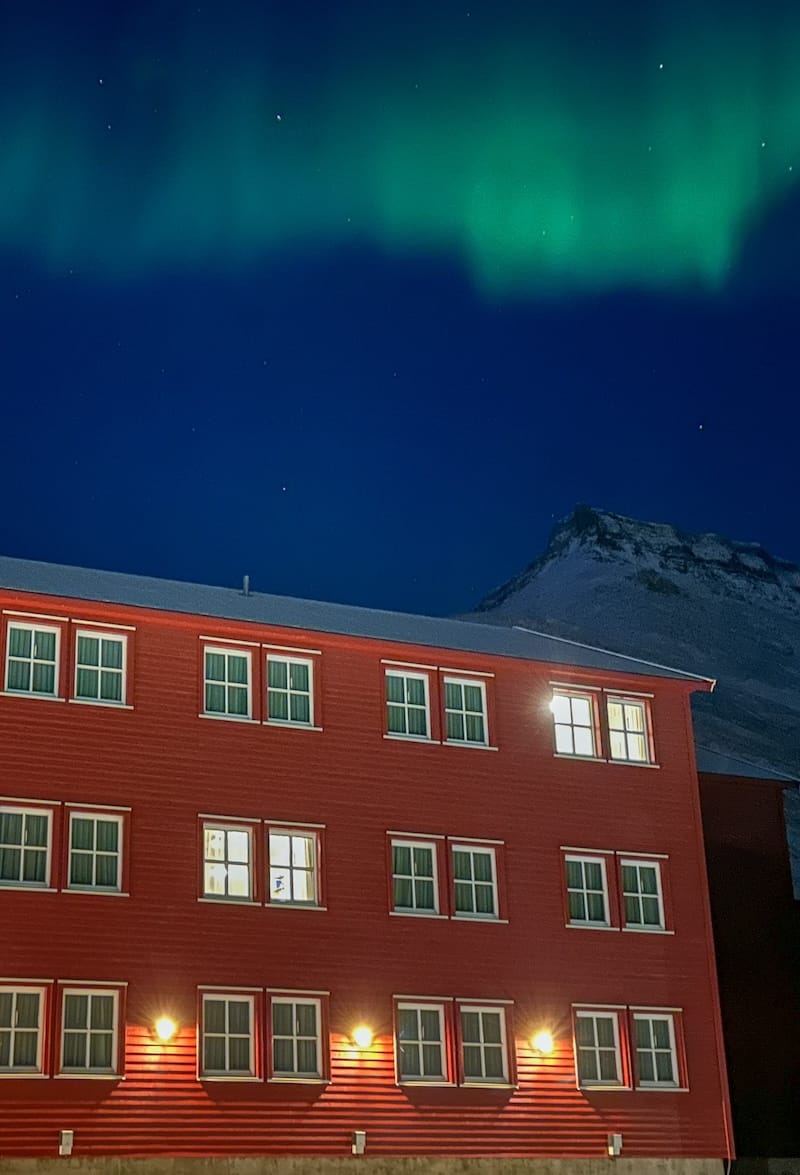
Another great reason to visit Svalbard in September is the Longyearbyen Litteraturfestival, where you can discover local authors. It is one of the top things to do in Svalbard during the fall.
For those who are looking to spot wildlife, be aware that the weather becomes more unpredictable towards the end of the month (this can affect boat trips and excursions).
FAQ about When to Visit Svalbard
What is the best month to see polar bears in Svalbard?
The best time to see polar bears in Svalbard tends to be during the summer (from May to August) because you’re able to cover more ground across the island of Spitsbergen.
The island of Spitsbergen only has around 300 polar bears or so, and taking a boat trip around the island gives you a better chance of seeing one.
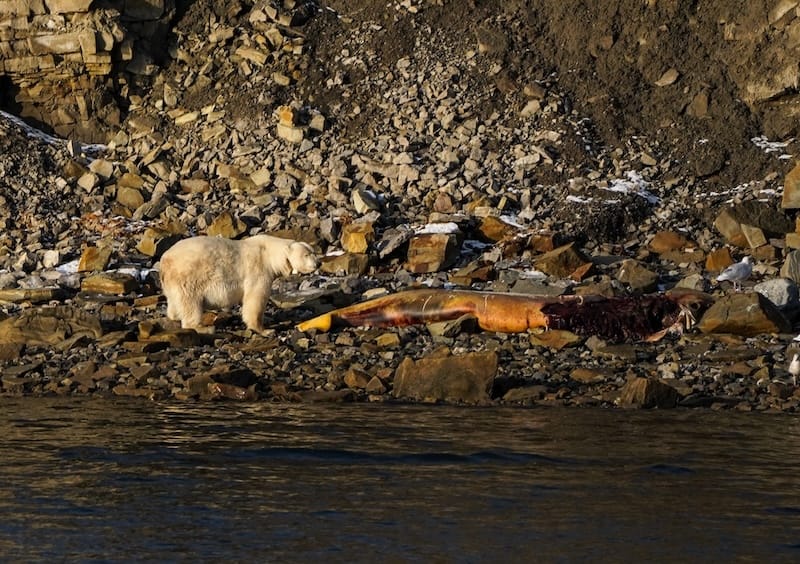
Contrary to popular belief, not all polar bears hibernate, only pregnant females. This means that you can technically see one at any time of the year.
What is the best season in Svalbard?
Honestly, it depends on what you’re interested in doing when you visit Svalbard. If you’re keen to go on a boat, visit during the summer months. If snowboarding is more your cup of tea, head to Svalbard from February to April.
Summer on Svalbard gives you a chance to see flora, enjoy the midnight sun, and do a little wildlife watching from a boat.
Winter on Svalbard gives you a chance to enjoy snow activities, the northern lights, and fewer crowds.
What month is the best to see the northern lights in Svalbard?
The ideal time to witness the northern lights (Aurora Borealis) in Svalbard is in the winter, or anytime the polar night is around.
Typically, the peak months for seeing the northern lights in Svalbard are from late October to mid-February. During this period, the nights are darker, significantly improving the chances of witnessing the auroras.

There is also little light pollution on Svalbard, making it a good place to check them out if they are active.
Do you have any questions about the best time to visit Svalbard? Let me know your questions in the comments, and I will do my best to answer!
More Svalbard Travel Guides
- Svalbard travel tips
- Best things to do in Svalbard
- Animals living in Svalbard
- Northern lights tours on Svalbard
- Camp Barentz
- Svalbard walrus safari
- Arctic wildlife tour in Svalbard
- Svalbard mine tour
- Svalbard boat tours
- Svalbard Museum information
- Where to eat on Svalbard
- How to visit a Svalbard ice cave
- Where to stay in Svalbard
- Best Svalbard tours
- Svalbard in winter
- Snowmobiling in Svalbard
- Failed trip to Pyramiden
- Beer tasting in Svalbard
- Svalbard in March
Pin this Best Time to Travel to Svalbard Guide

Megan is a travel blogger and writer with a background in digital marketing. Originally from Richmond, VA, she now splits her time between Frankfurt, Germany and Arctic Finland after also living in Norway, Armenia, and Kazakhstan. She has a passion for winter travel, as well as the Nordic countries, but you can also find her eating her way through Italy, perusing perfume stores in Paris, or taking road trips through the USA. Megan has written for or been featured by National Geographic, Forbes, Lonely Planet, the New York Times, and more. She co-authored Fodor’s Travel ‘Essential Norway’ and has visited 45 US states and 100+ countries.

